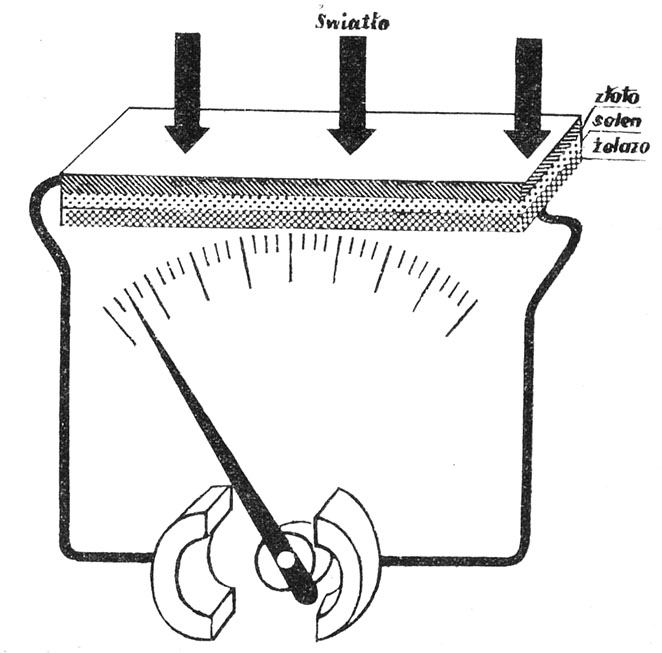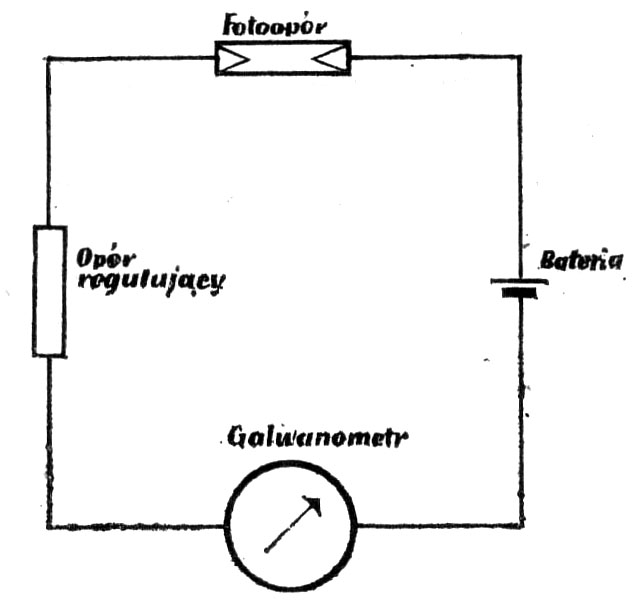LIGHT METERS.
Currently, only photoelectric light meters are used, in which the phenomenon of the generation of an electric current when light falls on a properly constructed photoelectric cell was used.
There are two types of photoelectric exposure meters: selenium, based on measuring the current generated by the action of light on a photovoltaic cell, and resistance (sulphide-cadmium), equipped with its own power source (mercury battery), measuring changes in photoelement resistance, under the influence of light in a circuit with a built-in cadmium sulphide resistive photoelement.
Drawing. Construction diagram of a selenium light meter.

Photoelement of a selenium light meter (drawing) consists of an iron plate with a thickness of approx. 1 mm, on which a thin layer of selenium is applied. The selenium layer, in turn, is covered with a very fine precious metal foil, np. gold. The foil is so thin, conducts electric current, it transmits almost all the light radiation falling on it. So when a ray of light falls through the metal foil onto the selenium layer, between the film and the tile, a weak one is formed, but measurable, electric current. The foil shows a negative potential, and the iron plate positive. By connecting both poles to the galvanometer, the deflection of the needle is obtained, to read the measurement on the appropriate scale. Of course, such instruments must be very precise.
The photoelectric light meter can measure the intensity of the light reflected from the photographed object or incident on the photographed object. Most photoelectric exposure meters measure the light reflected from an object.
Selenium light meters are built like this, that their angle of view is as close as possible to that of a normal lens.
Drawing. Schematic diagram of a resistive light meter.

In the resistive light meter (drawing) the resistance of the semiconductor CdS photoelement changes in proportion to the light intensity, falling on the light meter. As the light intensity increases, the resistance of the photoelement decreases. The current source is a miniature mercury battery with a voltage 1,3 wolta, with a durability of approx. 2 lata.
Resistance light meters are theoretically 100-150 times more sensitive than selenium ones. They can have a very small viewing angle (np. Gossen's Lunasix has an angle of 30°, and there are also angles of 2°), while selenium exposure meters have an angle of view usually approx. 60°. Reducing the viewing angle has a positive effect on the measurement precision, because it can be aimed at the most important parts of the photographed object. However, resistive light meters are several times more expensive than selenium ones, big and quite heavy. Light meter of this type, np. Gossen's Lunasix weighs approx. 200 g, it's as big as a photo format camera 18 X 24 mm and costs twice as much, what is a selenium light meter.
Resistance light meters are usually built into cameras with automatic through-the-lens light metering. As a separate instrument, they are also manufactured by many factories. The high sensitivity of resistance light meters is very valuable when working in extremely difficult conditions (np. in the night).
The resistive light meter coupled with the shutter-aperture system is an essential design element of most cameras, equipped with automation. Some cameras have a selenium light meter built into the body that is not coupled to the shutter-aperture system (aparat Zenit E lub Praiktica LB).
The light meter should be large, legible digits not too densely placed next to each other, and the construction is strong and resistant to shocks.
However, one should not judge, that the light meter works completely automatically. The deflection of the needle depends on the amount of light, which enters the instrument through its lens. So if you point it at a black wall, against which sits a person dressed in white, the reading of the exposure time will be false, because it depends on the amount of light, that is sent by a black wall and a person dressed in white, so this time is much longer than the proper one. The light meter always gives the sum of the light reflected from the plane corresponding to the angle covered by the instrument. Then get as close to the person as possible, trying, so that it fills the entire angle of view of the instrument and only then read the result. You have to be careful in the remote landscape, that the light meter does not indicate light coming from the sky and from the ground (snow). If there is heaven
blindingly bright, this amount will be too small, to give a good picture of the terrain. Then aim the light meter slightly downwards, to reduce the amount of rays from above (skies). The exposure time determined by the instrument will then be longer and closer to the correct one.